Domain Companies has closed on a $176 million construction loan to complete a 360-unit two-tower development at 420 Carroll Street in Gowanus, Brooklyn. Designed by FXCollaborative, the waterfront property will comprise a 20-story tower, a 15-story tower, and a publicly accessible connection to the Gowanus Canal promenade.
According to the developer, 25 percent of the apartments will be designated as affordable housing, available to households at 40 to 100 percent area median income (AMI). Amenities will include coworking space, a resident lounge, multiple outdoor spaces, a fitness center, a children’s playroom, and bike storage. Additional components include 27,500 square feet of retail.
“We are excited to advance 420 Carroll and support sustainable development in the Gowanus neighborhood,” said Matt Schwartz, co-CEO of Domain Companies. “After working closely with individuals and organizations across the community for the past several years, this closing marks an important step forward in delivering much needed mixed-income housing for Gowanus and New York City.”
The development site is located within an 82-block rezoned area surrounding the Gowanus Canal. The initiative to rezone the area is expected to facilitate the construction of more than 7.6 million square feet of residential area, upward of 1.5 million square feet of commercial area, and an overall reduction of vacant, underutilized land. These developments would also include expanded community facilities, publicly accessible open space, and parking.
In 2018, Domain Companies acquired 420 Carroll Street from Property Markets Group for a reported sum of $47.5 million. Total development costs are estimated at $295 million, and the project will utilize New York City’s 421a tax abatement program.
420 Carroll Street, already under construction, will be one of the first properties to debut as a result of the Gowanus rezoning initiative.
Upon completion in 2024, the development is expected to achieve LEED Platinum certification.
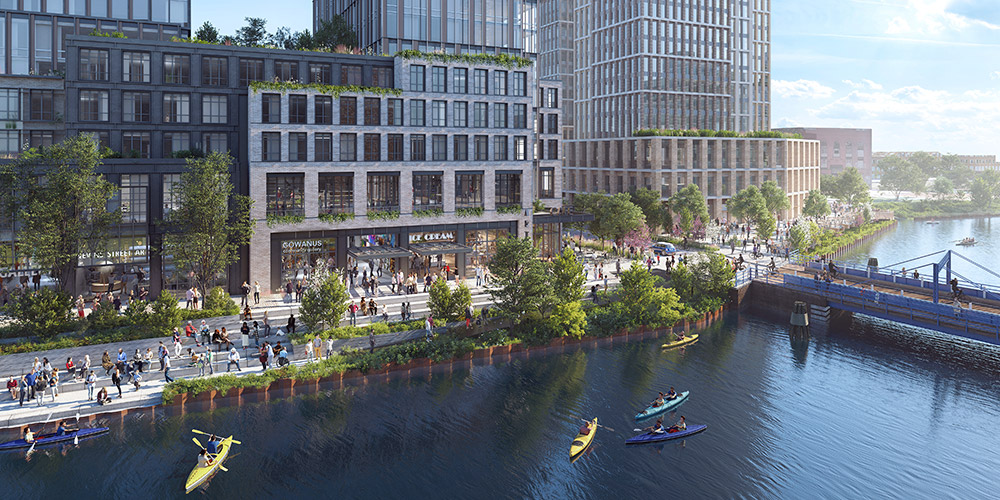
Rendering of the rezoned Gowanus waterfront and public esplanade along Nevins Street – SCAPE; Gowanus Forward
Subscribe to YIMBY’s daily e-mail
Follow YIMBYgram for real-time photo updates
Like YIMBY on Facebook
Follow YIMBY’s Twitter for the latest in YIMBYnews

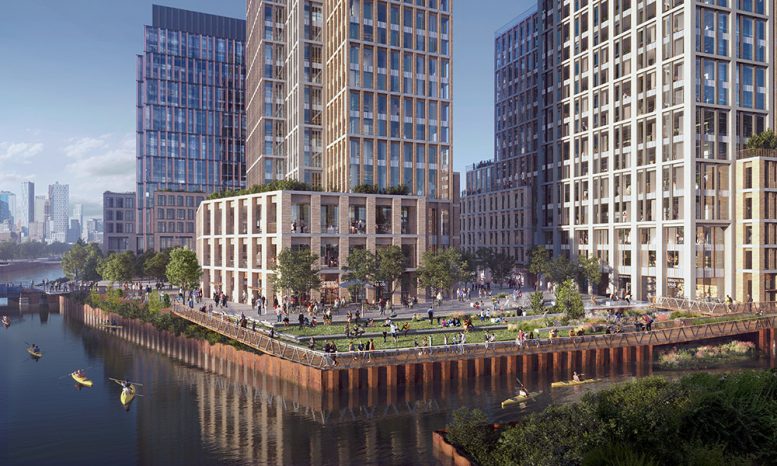
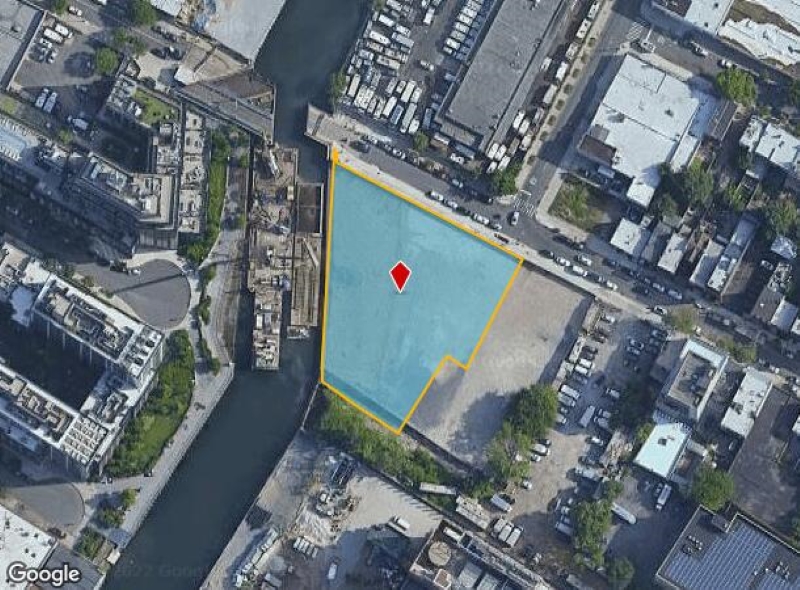
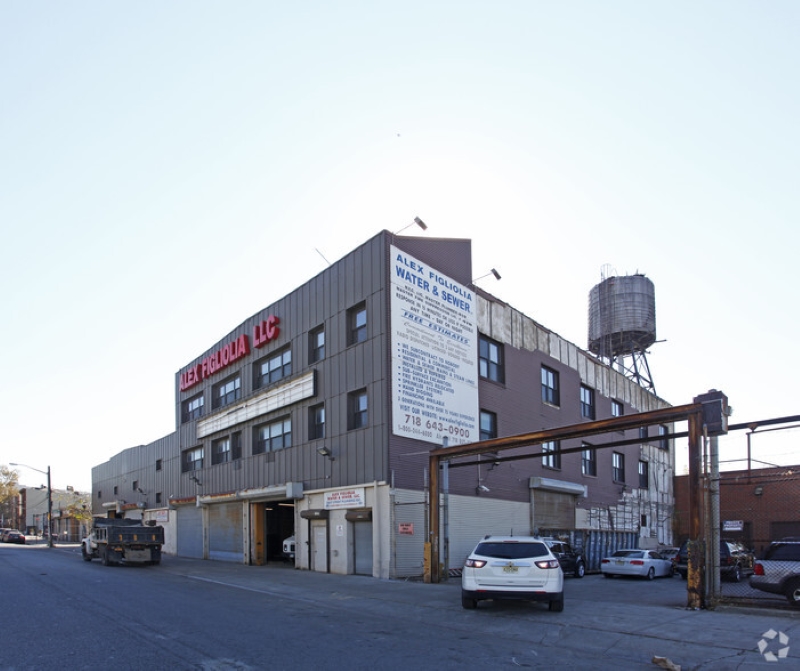
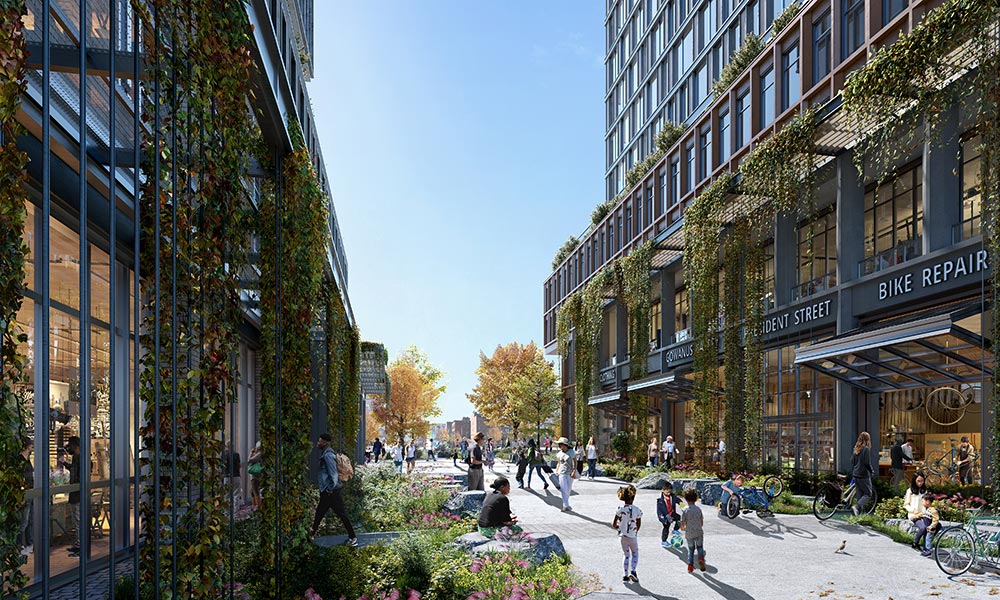
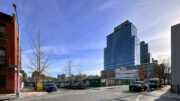
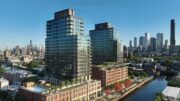
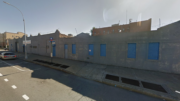
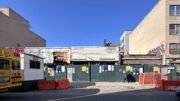
What is the Gowaus Rezone?
The Gowanus Rezone was originally proposed under the Bloomberg administration while now-Mayor de Blasio was still the councilperson representing District 39. Originally limited to 12-story buildings with 20% affordable housing, the ambition of the upzoning has exploded since Councilmember Brad Lander was elected to replace de Blasio. The new plan, developed in partnership with developers, rewards them with huge tax cuts and credits, while demanding very few benefits for the community.
It Is Enormous
Extends Far Beyond Gowanus: The rezoning plan spans 80 blocks bounded by Bond Street to the west, Baltic Street to the north, 4th Avenue to the east from Atlantic Avenue to 15th Street and cuts off near Hamilton Avenue. It is the single largest rezone proposed during the de Blasio administration.
Huge Influx of New Residents: The plan would bring 8,200 additional apartments to the neighborhood — and at least 20,000 new residents.
Dozens of New Luxury Towers: The plan would allow 22 to 30 story towers to be built lining both sides of the Gowanus Canal, and along 4th Avenue between 9th Street and Atlantic Ave, and in other areas. The yellow buildings in the image above identify the new luxury apartment buildings proposed for the neighborhood.
Majority of Apartments Will Be Super Expensive: 70% of the new housing would be high-end luxury apartments, with rents well above $3,000, according to current trends.
It Is Environmentally Irresponsible & Dangerous
Deeply Toxic Land: The land surrounding the Gowanus Canal once housed different types of industries that produced toxic waste that has seeped deep into the ground. The parcel of land called Public Place has coal tar at depths of 150 feet and after remediation will still need to be monitored in perpetuity — this is the land where a school and most of the affordable housing is planned. And the City keeps reducing how much it will clean this area.
The Canal is Extremely Toxic: The Gowanus Canal is one of the most polluted waterways in the United States as a result of over a century of industrial and municipal negligence. In fact, the Gowanus is so polluted that the federal government recognized it as a Superfund site in 2010 for its imminent threat to community health. The Gowanus Canal is not only full of industrial runoff, it also has a pathogen level that is a threat to human health as a breeding ground for antibiotic-resistant organisms.
Overwhelming Canal with Raw Sewage: When the sewer system in the area can’t handle all of the water coming into it, the excess runs directly into the Gowanus Canal. The 20,000 new residents the rezone proposes to bring to the neighborhood will increase the amount of waste entering the area’s sewer system tenfold. In fact, the EPA recently said there was no way to keep the water clean with the amount of development that is being planned.
Building in a Flood Zone: Most of the area to be rezoned is in a FEMA Flood Zone A — land that is most likely to be overwhelmed if another Hurricane Sandy should hit the area. Environmentalists and others are demanding that we don’t build more housing in flood zones, putting more people in harm’s way.
Impedes Canal Cleanup: The residents of Gowanus, along with Representative Nydia Velasquez, fought very hard —against the wishes of then-councilmember Bill de Blasio— to get the Federal Government to clean up the canal. Our current councilmember Brad Lander did nothing to assist this effort. But the City is now reneging on its responsibilities to address the CSO discharges, and has already delayed the cleanup for over a decade, claiming they don’t have the money needed. Yet the City is about to subsidize an enormous rezone. Why are new luxury towers more important than a clean canal?
On Earth Day 2015, environmental activist Christopher Swain swam through the Canal to raise awareness in the community about the water’s toxicity. Swain described the Canal as being the dirtiest water that he had ever swam in, and commented that it was like “swimming through a dirty diaper.”
It Is Expensive
The city proposes incentivizing private developers to build wildly profitable luxury housing, while passing the risk to NYC taxpayers. These developers will receive decades-long tax breaks and credits, costing billions in taxpayer funds.
Millionaires Will Pay No Property Tax: Because of the 421a program, developers of luxury apartment towers will not pay any property tax for 35 years. The 421a program is estimated to cost the city $2.4 billion a year in lost tax revenue. And who is going to pay for the infrastructure required for 20,000 new residents?
Taxpayers Will Be on the Hook for Three Times What it Costs to Clean the Land Each developer will be responsible for cleaning their own plots of land, potentially exposing neighboring residents to toxic fumes during their work. As part of the Brownfield Cleanup Program, developers will then be reimbursed three times what it cost them to do the cleanup, up to $35 million for each development. These are our taxpayer dollars, going directly to millionaire developers, while the city is facing an economic crisis.
Wealthy Investors Will Pay NO Taxes on Profits: Almost the entire area to be rezoned is part of an “opportunity zone,” a special designation that is given to “distressed” communities, and which allows investors who make money on the rezone to avoid paying any taxes on their profits. In New York State, losses from the “Opportunity Zone” program may amount to as much as $63 million annually for New York State, and an additional $31 million annually for New York City
Elimination of Jobs: The plan will eliminate many of the existing manufacturing zones, thereby eradicating the opportunity for new, diverse jobs. This, at a time when bringing industry back to NYC is what experts are recommending will spur economic growth.
It is Unjust
Luxury Housing In Distressed Neighborhood: Our elected representatives use misleading data to justify building luxury housing by claiming the new housing is being built in a wealthy neighborhood. In fact, the rezone area has been designated by the Federal Government as an “Opportunity Zone” — a low-income census tract with an individual poverty rate of at least 20 percent and median family income no greater than 80 percent of the area median—thereby threatening current residents with displacement. Studies of prior rezones in the neighborhood have been proven to have displaced thousands of BIPOC and low-income residents.
“Affordable” Apartments, Toxic Land: Our electeds promise that a small proportion of the new housing will be affordable. What they don’t mention is that the largest area of affordable housing will be built on what is perhaps the most polluted land in the United States. They also don’t mention that the vast majority of the so-called “affordable” housing will only be available to those earning $100k or more.
Real Estate Industry Bought Off Electeds: Our elected representatives have raised hundreds of thousands of dollars from luxury real estate developers. This is not a plan for current or future residents, but for the ambition of the real estate industry, and the politicians they own.
Brad Lander Ignored Constituents’ Plea: Despite the fact that 1500 people signed a petition, and over 400 sent letters, demanding a moratorium on the rezone given the pandemic and economic outlook, Brad Lander continues to forge forward, without even acknowledging the letters from his constituents.
“Virtual” ULURP is Illegal: Brad Lander and the Department of City Planning are pushing for a “virtual” ULURP (Universal Land Use Review Process) for his rezone, meaning meetings that are meant to take place in person will happen online. Assemblywoman Jo Ann Simon and others have voiced their opposition to this approach, arguing that the community deserves an in-person process. In fact,”virtual ULURP” is downright illegal.
What the Community Decides, Developers Override: During a series of contentious meetings that Brad Lander called “Bridging Gowanus,” there was one thing the vast majority of participants agreed on: they didn’t want the to would bring a forest of tall luxury towers and overwhelm the neighborhood. The initial rezone plan acknowledged those concerns somewhat. But after developers lobbied the Councilmembers and Community Board members for much greater heights, the revised plan gave them just what they wanted, and now the towers can reach to 30 stories—five times as tall as neighboring buildings. So why did we waste our time at these pointless meetings?
Racial Justice: Voice Of Gowanus has asked for a Racial Impact Study ahead of the rezoning to make sure that ALL current residents are protected from this massive land grab, a request that many other community groups signed onto. Councilmembers Lander and Levin have not supported this ask, despite co-sponsoring the very legislation (1572-2019) that calls for a mandated racial impact study to be undertaken for any land-use actions that require an Environmental Impact Study (EIS). The legislation was based on studies that showed that the previous rezone of Fourth Avenue, in 2003 displaced many people of color. Fourth Avenue will be upzoned even further as part of the new plan. A Racial Impact Study prior to the rezone would be able to predict whether the current rezone plan would have a similarly dire effect on the area’s current residents.
Join us in our fight for a better, greener, and more equitable plan for Gowanus!
Image credits, from top: 3D model of a fully built-out Gowanus after rezoning by New York Institute of Technology students; Map from the Department of City Planning; Image from Pardon Me for Asking of Gowanus flood during Superstorm Sandy; Illustration of the “new Gowanus” from DCP Gowanus Framework; Image from Pardon Me for Asking Blog.
Comments or Ideas about the Gowanus rezone plan or this site? Share them here.
TLDR.
Plus I’ve read it before since its the same screed you post in every Gowanus article.
I wish the ugly sheet pile bank walls along the Gowanus could be replaced with terraced stone blocks.
If they go very deep, I suspect they need to be there as part of the toxic waste remediation to keep the land and canal isolated from each other, though I am not sure if it is to protect the lad, the canal, or both. Still, a terraced stone facade would be an improvement. If they were just cleaning the canal but maintaining manufacturing and industry along it, the steel would give it a nice feel. Not so much with parkland and apartment buildings.